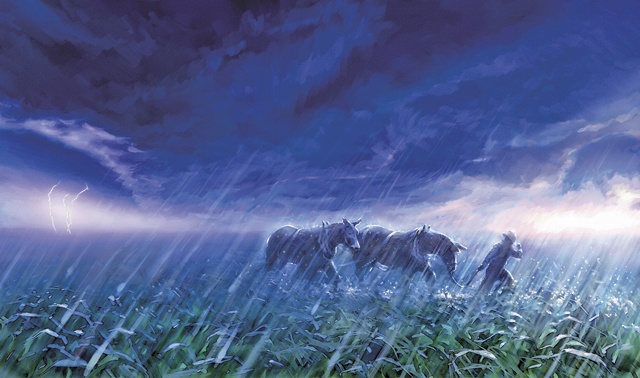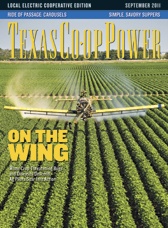The seasons and the pages of our lives turn with the weather.
Up here on the Texas High Plains, we experience the perpetual turning of the seasons in the cycles of sun and moon, wind and clouds, the constants of the ever-changing weather.
Weather is the foremost stuff of a morning’s initial coffee conversation when the farm and ranch crowd gathers early in and near such towns as Bootleg, Bovina, Nazareth, Hart and Hereford.
Markets and local happenings—and on some days, maybe even politics—will get their hashing out, but always it is the life force that is the weather that will be the lead story. The old saw that folks can’t do anything about the weather rings true, but we can certainly all get in our licks talking about it.
Many High Plains farmers and ranchers have crinkles around their eyes—marks of the good humor that is characteristic of working in the sun and wind and squinting at rain gauges. From the early days of spring into autumn, and in winter months, too, they carefully measure the quantity of liquid life that falls from the sky. For the most part, farm and ranch folk delightedly ponder the rainwater level in the glass cylinder, measure it against the ruled lines on the holder, then reverently pour out the meterings of this gift from their maker. What periodically pools in the rain gauge pretty well determines how agrarian lives will go as the calendar pages flip over with astonishing rapidity.
Most years, with a little luck, abbreviated periods of wet somehow wedge themselves between expansive, prolonged and windswept intervals of the dry that is another inevitability with death and taxes on the Plains. The interplay of the opposites of wet and dry dictates mood and outlook, and ultimately, what is realized from the land in grass and grain, bushels and beef on the hoof.
Thus it has ever been, the vagaries of the weather testing the hardiness of Plains folk from ancient times to now. As some historical accounts go, imagine the horrified amazement of the Spanish conquistadors encamped on Blanco Canyon in the eastern edge of the Llano Estacado near present-day Floydada in 1541, when, in the written words of the late, great Texas Panhandle historian Frederick Rathjen: A sudden “frightful hailstorm, apparently a new experience, occurred and injured horses, destroyed equipment, and battered bewildered men.”
The harsh reality of the changeable Plains weather is always hard on those caught out in it. I remember my late dad, Pete, telling of the time he was on the far southeast corner of the place that would one day be a part of the family farm on which I grew up. He was working well over a mile from the house or any barns, sheds or trees that day, cultivating maize with a team of mules.
Clouds, colored the familiar, sinister shades of gray, dark blue and pinkish purple that spelled trouble, gathered with amazing swiftness. Wary of lightning, he unhitched the team from the cultivator as the first big raindrops pattered.
Then came the thuds of the first jagged, icy hailstones, sluicing through maize leaves, clanking off the cultivator frame. Faster and harder they came, hammers of the heavens beating down. No real shelter to be had in a maize field.
Holding the reins for dear life, he gathered in slack. There was nothing for it. He hunched between the mules, a dicey proposition at best. So long as he kept his grip and held steady, the long ears shielded him from at least some of the icy projectiles, but the risk of mayhem from hooves or an outright runaway was as real as the clubbing hail. He leaned against one wet flank and another. Hail. Hell. Hail Marys.
I can only imagine the thumps of ice upon flesh, the groans and bawling brays of the hail-bludgeoned animals being worked over by the weather in the field where they had innocently gone about their plodding work, the splashing and slashing of hailstones in puddles and against leaves being torn asunder. There was no knowing how long the sudden hailstorm and the suffering of man and beasts would last.
I do know without ever having asked that just as soon as he could, Dad got that team headed for the home place, though its welcoming form was likely still veiled in the rain.
I know somehow that he got those battered mules to the barn, and before he did anything for himself he got them unharnessed, fed, and stalled, their bruises and wounds seen to gently in the very best way he knew how.
When rattling and the rain let up, I have a feeling that he stepped out the barn door, rubbing bruised arms and shoulders, knots on his head, and saw a gorgeous arcing rainbow. No matter life’s weather, he could always do that.
——————–
Jim Steiert is an agricultural freelance writer living in Hereford. He is the author of two books: Playas: Jewels of the Plains and Country Turnrows: A Voice from the Heartland. A version of this essay originally appeared in the June 2010 issue of Co-Op Connection, the newsletter of West Texas Rural Telephone Cooperative in Hereford.


